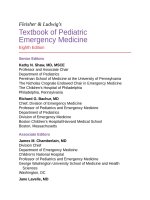Pediatric emergency medicine trisk 0339 0339
Bạn đang xem bản rút gọn của tài liệu. Xem và tải ngay bản đầy đủ của tài liệu tại đây (70.1 KB, 1 trang )
dangers, and gravitational forces. Helipad availability, landing zones, and other
issues of aircraft accessibility must also be determined. Although these logistical
issues are ultimately the responsibility of the air transport service and are usually
predetermined for the interfacility transport, additional or updated information
should be provided by the referral center personnel. On the helipad or tarmac, one
must be especially careful around aircraft with engines running (“hot loading”).
The helicopter’s tail rotor and plane’s propellers are often invisible when turning
but capable of inflicting severe damage upon those who venture too close. Loose
clothing, medical equipment, and stretcher pads can become entangled in a
helicopter’s rotors, causing severe damage to the aircraft and to the
passengers/staff of the transport. In general, only crew and specifically trained
personnel should approach an aircraft, especially if the engines are running or
potentially starting. Approach to the aircraft should always be done under the
direction of the flight crew or designated flight safety personnel.
MEDICAL–LEGAL ISSUES
Patient transport is governed by a variety of federal, state, and local statutes.
Transport teams and their members may be sued for malpractice under traditional
tort law. Therefore, it is important that all members of the transport team
understand applicable regulations and avoid unnecessary medical–legal risk.
Timely, legible, and complete documentation is imperative. This includes not
only the team members onsite, but also the communications personnel and the
medical team receiving information or giving advice. This documentation should
professionally address any decision points and inconsistencies in standard of
delivery of care, including responsiveness, mode of transport, personnel
notification, preparation for patient’s needs, and any delays that may be
anticipated or encountered.









